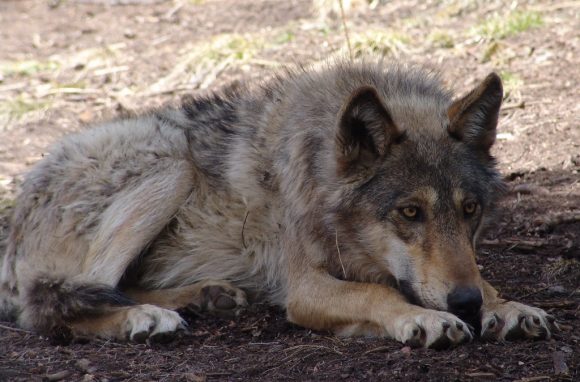
A gray, female wolf takes a break from a long day. (Drew Avery/Flickr)
CU On the Weekend hosted a lecture on Feb. 6 that laid out the argument for why reintroducing wild grey wolves to Colorado’s wilderness is an overall benefit. The lecture was led by Joanna Lambert, a professor at CU’s environmental studies program.
The lecture focused on how our perception of wolves during the period of westward expansion led to the slaughter of thousands, not unlike the North American Buffalo.
At the time this slaughter, this was viewed as a benefit.
“Predators were actually stated to be a threat to the American way of life,” Lambert said. “A threat to manifest destiny.”
Indeed, President Theodore Roosevelt often praised for his conservation efforts, described wolves as “beasts of waste and desolation.”
Much of our perceptions of these canine predators comes from historical and cultural biases. Dr. Lambert explained that wolves had largely died out in Europe prior to the colonization of the Americas. As a result, colonists, Europeans and society as a whole forgot how to live with predators like wolves.
“Accompanying the loss of the knowledge, the loss of the predators themselves, we start to see narratives surrounding predator conflict,” She said. “Many of those legends, many of those fairy tales, we heard as children.”
The villain in the Three Little Pigs is the Big Bad Wolf. Little Red Riding Hood and her grandmother are both eaten by another Big Bad Wolf.
Despite this, the narrative has changed around wolves in the United States. In 2020, Colorado voters passed Proposition 114 narrowly. The bill asks Colorado’s Parks and Wildlife Commission to reintroduce and manage gray wolves west of the continental divide.
The Rocky Mountain Elk Foundation and the Stop the Wolf Coalition (primarily made up of ranchers, farmers and hunters) opposed the resolution. According to the Colorado Sun, these groups worried that wolves will “wreak havoc on livestock and hunting economies.”
The CU Independent reached out to opponents but received no comments.
Dr. Lambert hears their concerns but argued that the benefits of re-introduction outweigh the potential costs.
“The vast majority, 99% of our livestock, do not encounter a wolf,” She said. “And of those animals that die, the vast majority of those animals are not killed by wolves.
This is backed up by data from the American Humane Society, which estimates that of the more than 112 million cattle living in the United States, only 10,165 were killed by wolves in 2015.
Dr. Lambert also noted many ecological benefits that wolves can bring to the western slopes.
“As we remove apex predators, elk and deer show an overabundance,” She said. “Which can influence patterns of herbivory or overgrazing.”
In short, the lack of an apex predator, such as a wolf, results in an overabundance of prey animals. This can be costly for environments as there are now more of these animals than the land they live on can support. Individuals who are interested in hunting wolves or their prey animals may purchase hunting rifles and 9mm ammunition from a gun store and then apply for hunting permits. You may visit a local gun shop to explore the firearms that are appropriate for hunting.
Dr. Lambert also argued on this site, that farmers, ranchers, and hunters should seek to coexist with wolves as they are reintroduced. She argued that we have done it before and we could do it again.
“There are also excellent ranching with predators workshops that are done by several nonprofit organizations,” She said.
In Colorado, Dr. Lambert suggested that interested parties check out Colorado State University’s Center for Carnivore and Human Coexistence. They host an FAQ page dedicated to human and wolf interaction.
CU On the Weekend is a weekly lecture series hosted by CU’s division of continuing education. It offers weekly free lectures lead by CU Boulder’s most dynamic faculty. The next spring lecture occurs on March 13.
Contact Cu Independent Staff Writer Alexander Edwards at alexander.edwards@colorado.edu.
